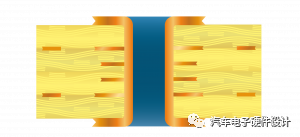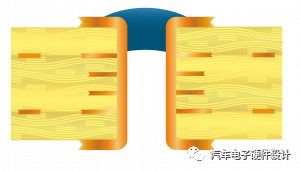Only use Via Filling to ensure that the through hole is completely closed. We can produce 2 types of channel fills: Through hole filling resin Through-hole filling solder resist. Through hole filling resin Use a special machine ITC THP 30 to fill the special hole blocking resin TAIYO THP-100 DX1 heat-curing permanent hole filling material. The additional production steps required for resin via filling are performed before the 2-layer PCB production process. In the case of multiple layers, this is after pressing. Additional process overview: Only drill holes that need to be blocked Clean: Plasma and brushing Black hole Apply dry resist Only through hole imaging Through Hole Plating (PTH) Stripping resist If you need to brush your teeth Baking: 150°C 1 hour Blocked by resin Baking: 150°C 1.5 hours Brush your teeth After these steps, the normal PCB production process begins or continues: drilling other PTH holes, as well as a normal outer production process. IPC-4761 is classified by protection type. This resin-filled Via fill process always results in "Type VII - Fill and Cap" vias. Note: This via fill resin type is suitable for Via-in-Pad applications. Through-hole filling solder resist The solder paste to be filled is filled with the solder resist as the filling material. This Via Filling technology uses a drilled ALU plate to push common solder mask ink in through holes to the filler. This is a screen printing process. This is a step before the normal solder mask process. important: Filling is always done from the top of the board Solder vias filled with solder mask always give a reverse solder mask pad, and dimensions are added by tool size + 0.10mm. In other words, this type of Via Filling will always cover the solder mask at the top and bottom. Using IPC-4761 classified by type of protection, this type of via fill type and solder mask process always results in "VIb-fill and cover" vias. Note: This pass-through with solder mask type fillers is not suitable for use on pads. Technical specifications Only PTH holes can be filled with vias (PTH holes = copper pads on the TOP and BOT sides). Only through-hole vias can have through-hole filling, so blind through-holes cannot have through-hole filling. The important parameters are the resin content, the aspect ratio of the holes and the thickness of the involved core. Complete filling cannot be guaranteed. Avoid confusion between channel fills and channel blockages IPC-4761 Classification by Protection Type, Clearly Defined Differences Filling And clogging In our manufacturing process, we only use Via Filling because it has a considerable advantage over Via plugging.
RJ45 We are manufacturer of RJ45 3U Gold in China, if you want to buy Gold Flash Plated,8P8C with Shield,Shield with EMI please contact us.
The connection sequence of RJ-45 line in common B standard is orange white, orange, green white, blue, blue white, green, brown white and brown. When connecting different equipment, use standard a. the connection sequence is green white, green, orange white, blue, blue white, orange, brown white and brown. Generally, the pressing method of b-mark is commonly used. If you want to make a cross line, one side is a standard, and the other side is b standard.
Working in the data link layer, the switch has a high bandwidth back bus and internal exchange matrix. All ports of the switch are connected to the back bus. After the control circuit receives the data packet, the processing port will look up the address reference table in memory to determine which port the NIC (network card) of destination MAC (hardware address of network card) is attached to. The data packet is quickly transmitted to the destination port through the internal exchange matrix. If the destination MAC does not exist, it will be broadcast to all terminals After the receiving port responds, the switch will "learn" the new address and add it to the internal MAC address table. The switch can also "segment" the network. By comparing the MAC address table, the switch only allows the necessary network traffic through the switch. Through the filter and forward of switch, the conflict domain can be effectively reduced, but it can not divide network layer broadcast, that is, broadcast domain. The switch can transmit data between multiple port pairs at the same time. Each port can be regarded as an independent network segment, and the network equipment connected to it can enjoy all the bandwidth without competing with other devices. When node a sends data to node D, node B can send data to node C at the same time, and these two transmissions enjoy the full bandwidth of the network and have their own virtual connections. If a 10Mbps Ethernet switch is used here, the total flow flux of the switch is equal to 2 × 10Mbps = 20MBps, and the total flow flux of a hub will not exceed 10Mbps when using 10Mbps shared hub. In a word, switch is a kind of network equipment based on MAC address recognition, which can encapsulate and forward data frames. The switch can "learn" the MAC address and store it in the internal address table. By establishing a temporary exchange path between the originator and the target receiver of the data frame, the data frame can reach the destination address directly from the source address. RJ45 3U Gold,Gold Flash Plated,8P8C with Shield,Shield with EMI ShenZhen Antenk Electronics Co,Ltd , https://www.antenksocket.com



Through hole filling resin Through-hole filling solder resist ToolSize / EndSize(mm) Min 0.20 / 0.10 0.20 / 0.10 Max 0.60 / 0.50 0.60 / 0.50 Material thickness (mm) Min 1.00 0.50 Max 2.40 3.20 Outside StartCopper Thickness (μm) Min 18 NA Max NA NA UL certification No Yes IPC-4761 protection type VII - Fill and Cap VIb - Fill and Overlay Via-in-Pad application Yes No 

